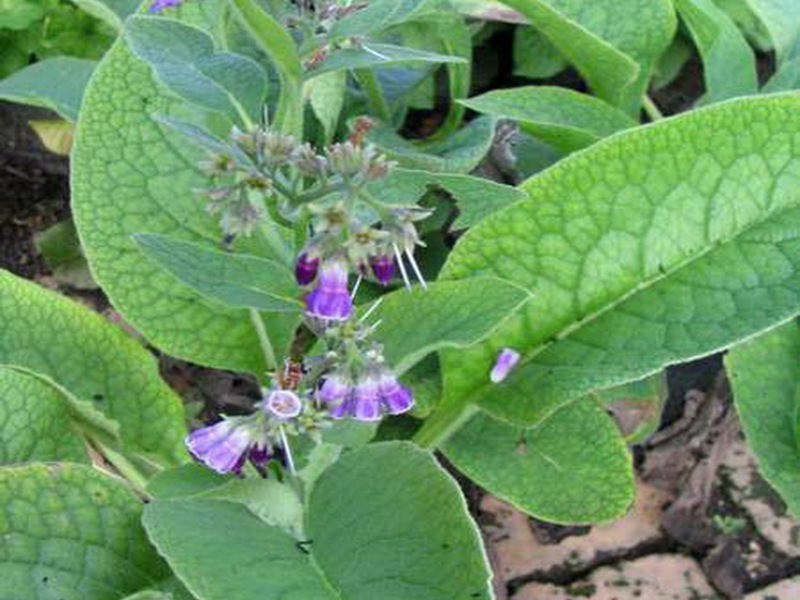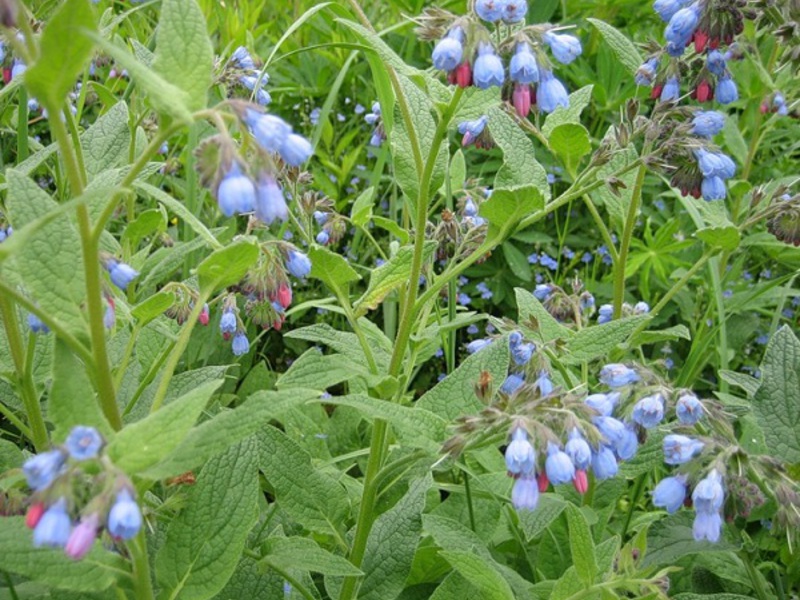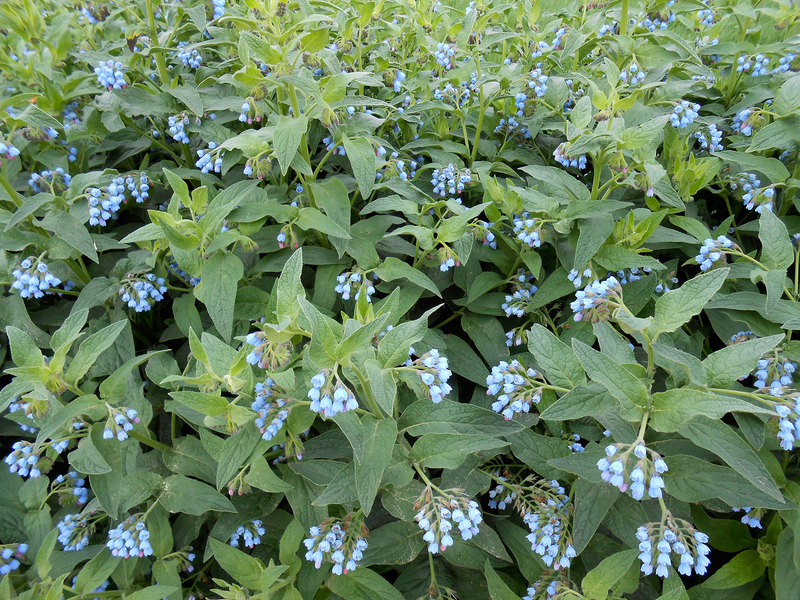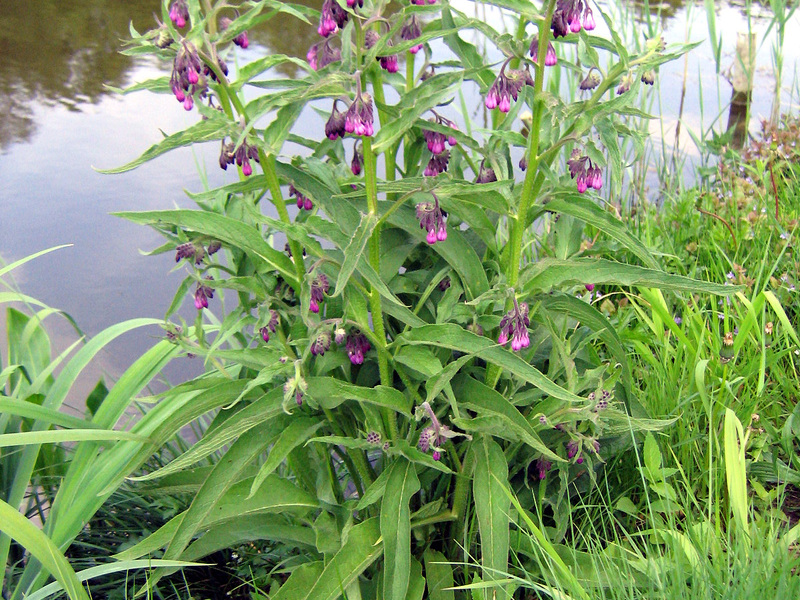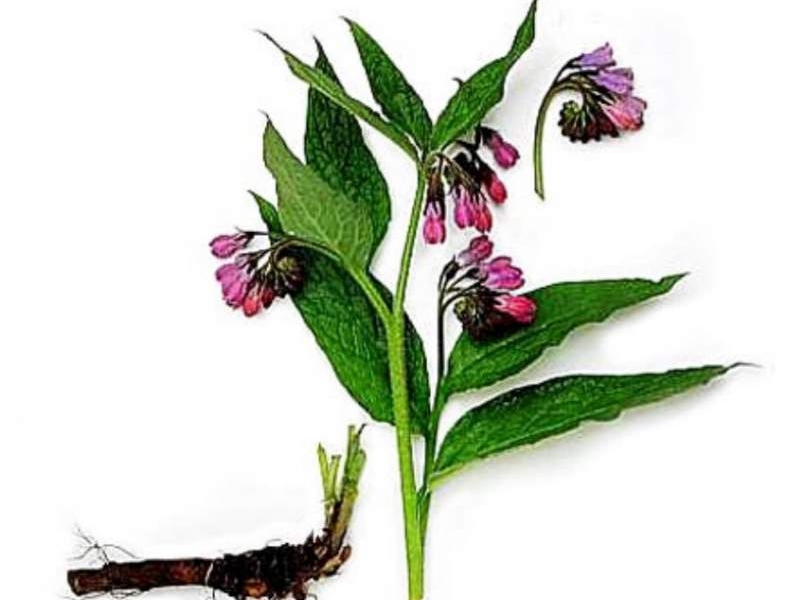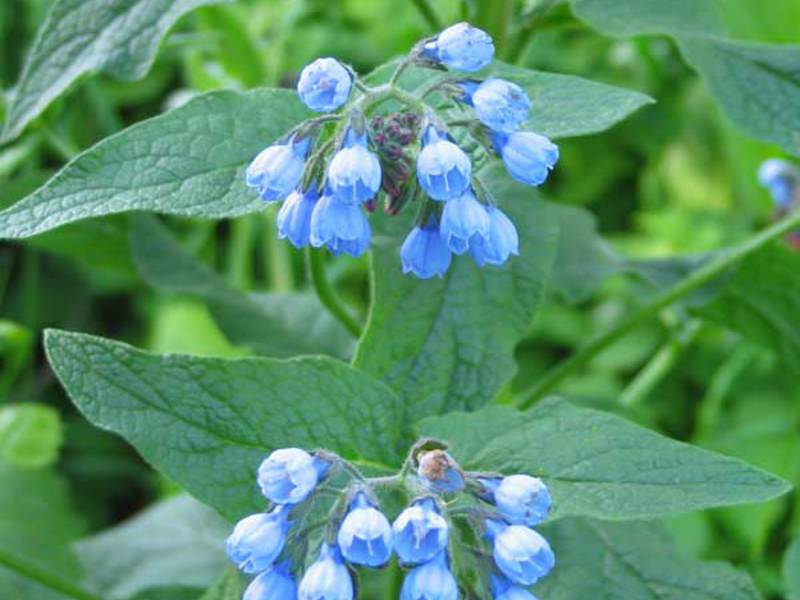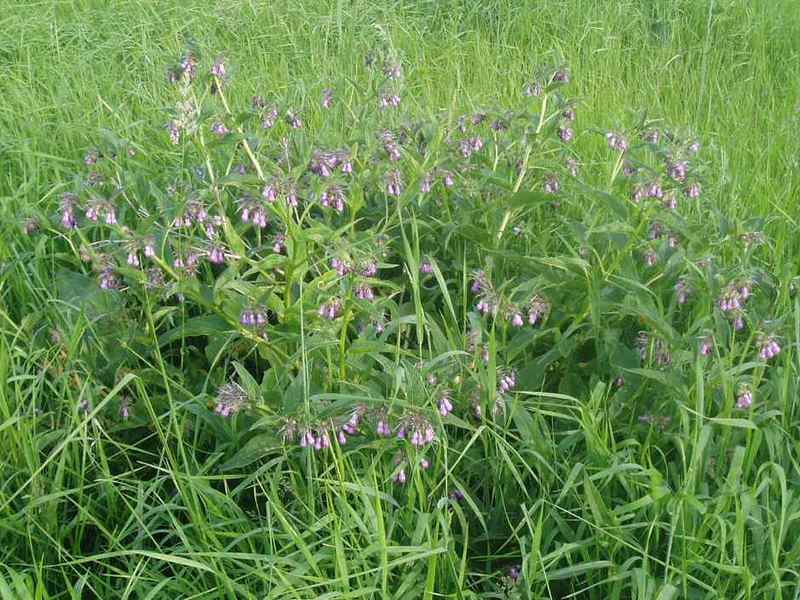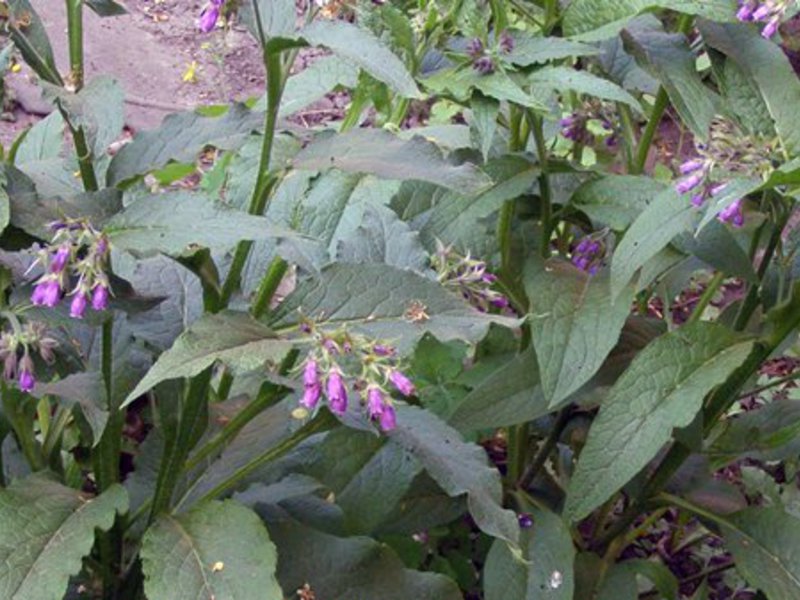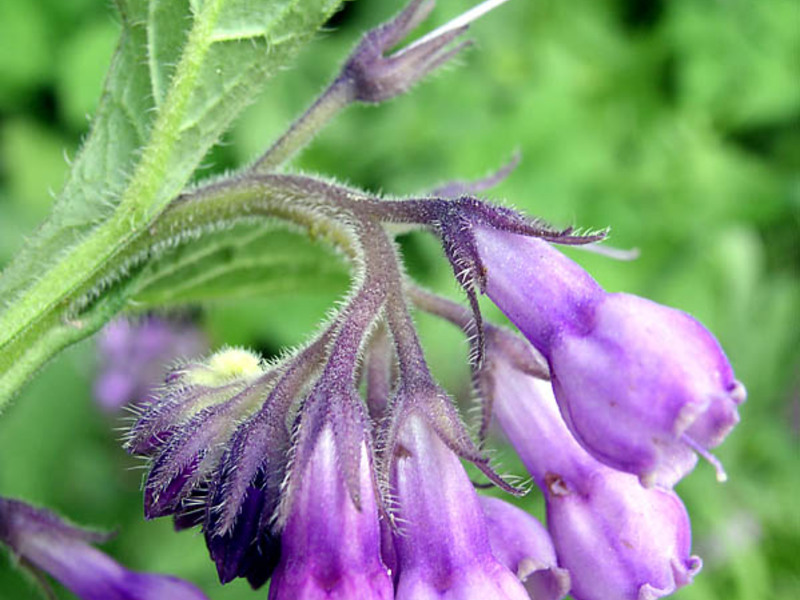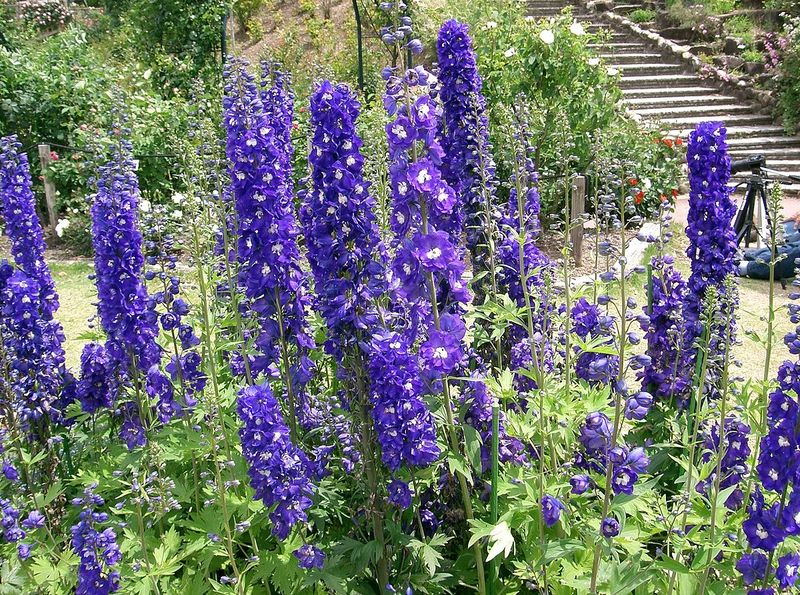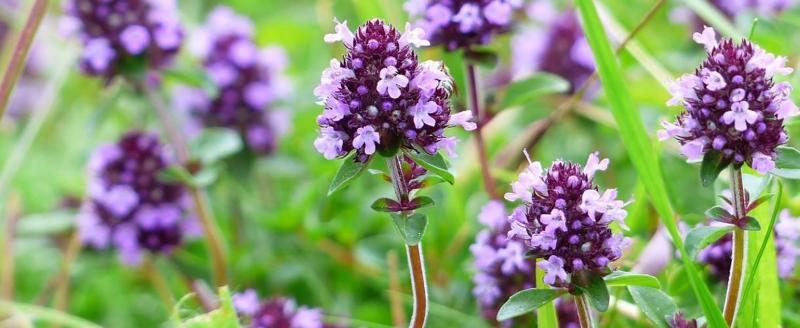Comfrey is the official name of the plant, which many know as the larkspur. People were able to evaluate its useful properties during the war and epidemic, since it can be used to effectively treat severe fractures and wounds. Therefore, every field doctor must have a comfrey with him. The healing effect of this plant is associated with its effects on bones and joints. With its timely application, damaged tissues begin to quickly recover, therefore it is often used for fractures, dislocations of joints and bruises. In other words, this plant is ideal for situations where it is necessary to disinfect the wound and speed up the process of tissue regeneration.
Content
Description and photo of comfrey
 Comfrey is one of the famous herbaceous plants that can be found in Europe and Western Asia... In our country, this plant is represented everywhere in the European part, in the south of Western Siberia, in the Crimea and the Caucasus. The favorite habitats of this plant are deciduous forests, clearings, wet meadows, water bodies, as well as forest ravines and the outskirts of swamps. It often grows near houses, in orchards and vegetable gardens, as well as in places where waste is stored, where high humidity prevails.
Comfrey is one of the famous herbaceous plants that can be found in Europe and Western Asia... In our country, this plant is represented everywhere in the European part, in the south of Western Siberia, in the Crimea and the Caucasus. The favorite habitats of this plant are deciduous forests, clearings, wet meadows, water bodies, as well as forest ravines and the outskirts of swamps. It often grows near houses, in orchards and vegetable gardens, as well as in places where waste is stored, where high humidity prevails.
Comfrey officinalis is a classic perennial, representing the borage family. In the process of growth, it forms a branched stem, which can grow up to 1 m.At the bottom, the plant has a tetrahedral shape, it is decorated with large oblong leaves, having a length of 10-15 cm and a width of 5 cm... The foliage at the bottom of the stem has long winged petioles, the leaves at the top are sessile. A characteristic feature of comfrey leaves and stems is the presence of hard hairs.
An adult plant has a short black root with a thickening. At the cut point, the rhizome is white, the pulp has a sweet, astringent taste.
During the growing season, small tubular-bell-shaped flowers are formed. They grow as panicles at the ends of the stem and branches. By themselves, they resemble a one-sided curl, which remains closed until flowering. When this time comes, the flowers begin to transform: at this moment they can acquire a purple, lilac or violet hue. Flowers usually begin to open between May and June.
At the stage of seed ripening, four smooth black nutsreaching a length of 4-5 mm. They usually ripen in July-September. Each adult comfrey can produce 800-1000 seeds per season. For reproduction, you can use seeds or divide the rhizome.
Comfrey roots and leaves are used for medicinal purposes. Collecting roots must be done in early spring before the leaves bloom. They can also be prepared in the fall, but only after the flowering time has passed. The collected raw materials must be thoroughly washed, cut and left in the drying room. This process takes a long time, since during the growth of comfrey roots accumulate a lot of moisture... Comfrey leaves are collected during flowering.
The roots of this plant are of great value due to the presence of biologically active substances in their composition: allantoin, alkaloid cinoglossin, saponins, tannins, etc.
Among specialists it is a family called Symphytum, which translated from Greek means "grow together". And this is quite logical, since the properties of comfrey make it possible to heal bone fractures. The species itself is called officinale, which can be translated as “medicinal”.
The name of this plant, which is popular among the inhabitants of our country, can be explained by the places where the comfrey grows. Most often it can be found in humid low-lying areas. It is also known under other names - borage, apothecary omentum, pravokost.
Comfrey officinalis: application
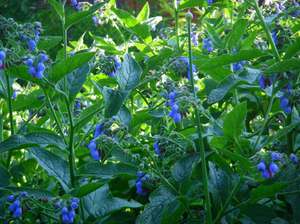 For a long time, folk healers were able to get acquainted with the beneficial properties of comfrey root. Preparations from this raw material are very effective in the treatment of bone fractures, wounds, kidney diseases, cough, bronchitis, pulmonary tuberculosis. They can also help with inflammation of the stomach and intestines, diarrhea, restore metabolism. As an external agent, they used in the fight against such diseases, as:
For a long time, folk healers were able to get acquainted with the beneficial properties of comfrey root. Preparations from this raw material are very effective in the treatment of bone fractures, wounds, kidney diseases, cough, bronchitis, pulmonary tuberculosis. They can also help with inflammation of the stomach and intestines, diarrhea, restore metabolism. As an external agent, they used in the fight against such diseases, as:
- stomatitis;
- purulent rashes;
- cracked skin;
- trophic ulcers.
For internal consumption, a comfrey-based product is used in cases where it is necessary to achieve the fastest healing of bones and tissue healing. Decoctions and herbal infusions have unique properties, thanks to which you can stop bleeding. They also help with hemoptysis, chronic inflammation of the respiratory system, as well as with the development of gastrointestinal diseases. External use of these funds is associated with the treatment of conditions such as:
- dislocations;
- fractures;
- bruises;
- inflammation of the veins;
- skin diseases;
- ulcers;
- wounds;
- rheumatic pains.
Using comfrey root
No other plant can be compared with this plant in the treatment of joint diseases, because it has healing, anti-inflammatory and anti-rheumatic action.
Such healing properties of comfrey herb can be explained by the fact that it contains a large amount of allantoin. This is a unique natural antibiotic that has a powerful bactericidal and anti-inflammatory effect, perfectly cleans the lesion, and triggers the formation of new, healthy cells.
This plant is indispensable for the treatment of fractures, severe bruises and dislocations, as well as for joint diseases, since it has the property of relieving inflammation and edema. But most important of all, it stimulates the cartilage healing process.
Infusion of comfrey roots
For this remedy, you need to take one tablespoon of crushed roots and pour one glass of hot boiled water. Then the mixture is allowed to brew for 6-8 hours and filtered. When the roots increase in size, they are again poured with 1 glass of boiling water, but now the duration of infusion is reduced to 30 minutes... After that, the infusion is filtered again. After the steps taken, two parts of the infusion are taken and combined. The finished product is drunk in two tablespoons every two to three hours.
This infusion helps in the treatment of chronic bronchitis, catarrh of the respiratory tract. Effectively fights inflammatory processes, facilitates the process of excretion of sputum.
Tincture of comfrey roots
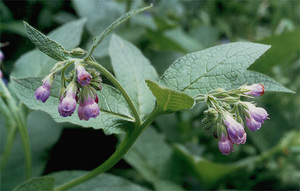 For this product you will need half a glass of fresh crushed roots, which must be filled with vodka 40 ° in an amount of 0.5 liters. Then the mixture is placed in a cool dark place. After 10 days, the finished tincture should be filtered. The remedy is drunk in 20-30 drops. Dosing regimen - 3-5 times a day before meals, adding to a small amount of water.
For this product you will need half a glass of fresh crushed roots, which must be filled with vodka 40 ° in an amount of 0.5 liters. Then the mixture is placed in a cool dark place. After 10 days, the finished tincture should be filtered. The remedy is drunk in 20-30 drops. Dosing regimen - 3-5 times a day before meals, adding to a small amount of water.
With the help of the infusion and tincture of the comfrey plant, you can speed up the healing process in case of bone fractures, dislocation of joints, severe bruises, osteomyelitis, as well as wounds and purulent periodontal disease.
Also, these funds are effective as baths, rinses, lotions, compresseswhich can be combined with oral administration.
The drugs can alleviate the patient's condition with chronic inflammation, stomach and duodenal ulcers, diarrhea, dysentery, chronic bronchitis - they relieve inflammation, pain in the intestines.
The beneficial properties of the infusion from this medicinal plant are manifested in improving metabolism, digestion and increasing appetite.
Comfrey root decoction
To prepare this product, you will need 1 tablespoon of roots, which must be poured with one glass of hot boiled water. Then the mixture is placed on the stove and boiled over low heat for 10 minutes. The finished broth must be filtered.
The tool is intended for internal and external use in the treatment of conditions such as:
- rheumatism;
- gout;
- wounds;
- boils;
- ulcers and other skin conditions.
Also, decoction of comfrey root can help people who have uterine, hemorrhoidal and other bleedingand there are signs of bladder inflammation.
It is useful to use a decoction of a medicinal plant to eliminate nosebleeds. This will require tampons, which are moistened in broth and then inserted into the nostrils. Also, this remedy can heal skin wounds, abrasions, bruises with hemorrhage.
Also, a decoction of the herb can be used for cosmetic purposes. For this, lotions are made to eliminate the effect of dry skin, as well as poultices that are effective against irritation, redness and peeling of the skin.
With regular use of a decoction of the herb, you can improve the condition of hair that has a problem such as alopecia areata - hair loss.
Conclusion
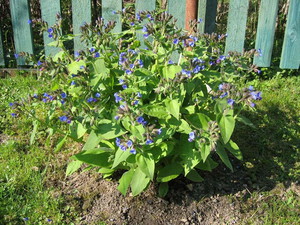 Comfrey is a fairly well-known plant in our country that is often used as an effective remedy in the treatment of fractures. Moreover, the most valuable part of the comfrey is roots from which preparations are made... The healing properties of comfrey are related to its ability to act on damaged tissues, triggering the mechanism of their regeneration. Therefore, this remedy is appropriate to use not only for minor injuries, such as wounds and abrasions, but also for more serious conditions, such as fractures.
Comfrey is a fairly well-known plant in our country that is often used as an effective remedy in the treatment of fractures. Moreover, the most valuable part of the comfrey is roots from which preparations are made... The healing properties of comfrey are related to its ability to act on damaged tissues, triggering the mechanism of their regeneration. Therefore, this remedy is appropriate to use not only for minor injuries, such as wounds and abrasions, but also for more serious conditions, such as fractures.
On the basis of the roots and leaves of comfrey medicinal, infusions, tinctures and decoctions are prepared, which can help with other painful conditions. Therefore, with inflammatory processes occurring in internal organs, as well as weakened immunity, many experts advise using drugs based on this plant.
